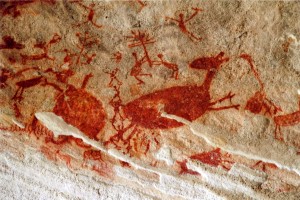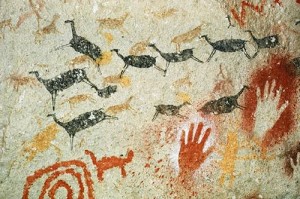Cave Painters
tle=”cave painters” src=”http://www.fanningart.com/wp-content/uploads/2010/11/cave-painters1-300×219.jpg” alt=”” width=”300″ height=”219″ />
cave painters
The mystery of the Palaeolithic cave paintings have always fascinated me since learning about them in Art History 1 in art school. The earliest surviving paintings are actually the dot painting petroglyphs in Australia which are as much as 50,000 years old. But the best known are the later cave paintings from northern Spain and southern France that are around 15,000 years old. All were painted with earth pigments showing it’s amazing permanence. In the Lascaux caves, they ground the earth pigments in hollows on the floor using heavy animal bones and stones. The clays were mixed with water, albumen, animal fat and blood to make very sophisticated paints. The paints were applied by brushing with the chewed ends of twigs, feathers and animal hair; smearing and dabbing using the hands and pads of mosses and lichen; and also applied with primitive air brushes- spraying through reeds and hollow bones.
Recent discoveries have shown that the people of Lascaux would travel up to 25 miles to collect their painting materials. Keeping in mind the extremely hazardous conditions under which early humans lived and their short life span, painting must have been extremely important. They painted not only their walls and ceilings but also their tools, clothing and bodies.
There are three theories about why so much precious time and energy was expended this way. #1. For pleasure or to tell a story #2. “Sympathetic hunting magic”- based on the belief that to paint a picture of a successful hunt helps to achieve it in actuality. #3. Artistic Symbolism- to represent the unknown, the natural and supernatural forces. I personally think that it was probably a combination of all three but primarily number 2. I bet they were masters of the law of attraction and created their reality with their drawings. What do you think?


